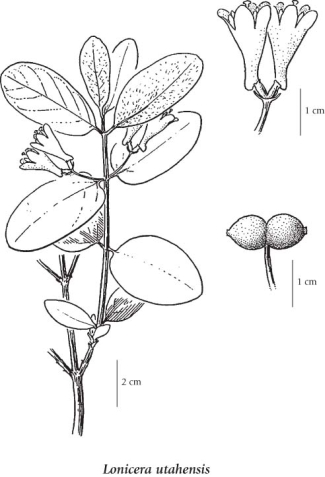Lonicera utahensis S. Watson
Utah honeysuckle (red twinberry)
Caprifoliaceae (Valerian family)
Introduction to Vascular Plants
Utah honeysuckle (red twinberry)
Caprifoliaceae (Valerian family)
Introduction to Vascular Plants
Introduction
Utah honeysuckle is a western North American species with white / creamy or yellow flowers that is found in "Moist to mesic meadows, grasslands, shrublands and open forests" in southern British Columbia (Douglas et al. 1998).
|
Species Information
General:
Deciduous, ascending or erect shrub, 0.6-2 m tall; twigs glabrous or nearly so.
Leaves:
Opposite, short-stalked, elliptic to somewhat egg-shaped or oblong, rounded to somewhat heart-shaped at the base, obtuse to rounded at the tip, 2-8 cm long, 1-4 cm wide, glabrous above, often thinly hairy beneath and on stalks.
Flowers:
Inflorescence of pairs of flowers in leaf axils, on the ends of 0.5-3-cm long stalks; involucres of 2 pairs of very small bracts; corollas cream or light yellow, funnel-shaped, 1-2 cm long, scarcely 2-lipped, the 5 slightly unequal lobes much shorter than the tubes, which are hairy within and have short thick spurs at the bases.
Fruits:
Berries, red, 0.7-1 cm across paired, united at the base, 2- to 4-seeded.
Illustration

If more than one illustration is available for a species (e.g., separate illustrations were provided for two subspecies) then links to the separate images will be provided below. Note that individual subspecies or varietal illustrations are not always available.
Illustration Source: The Illustrated Flora of British Columbia
USDA Species Characteristics
Flower Colour:
Yellow
Blooming Period:
Early Summer
Fruit/Seed characteristics:
Colour: Red
Present from Summer to Fall
Source: The USDA
Ecology
Ecological Framework for Lonicera utahensis
The table below shows the species-specific information calculated from
original data (BEC database) provided by the BC Ministry of Forests and Range.
(Updated August, 2013)
The table below shows the species-specific information calculated from
original data (BEC database) provided by the BC Ministry of Forests and Range.
(Updated August, 2013)
| Site Information |
Value / Class |
||
|
Avg |
Min |
Max |
|
| Elevation
(metres) |
1353 | 8 | 2460 |
| Slope
Gradient (%) |
27 | 0 | 235 |
|
Aspect (degrees) |
199 | 0 | 360 |
| Soil
Moisture Regime (SMR) [0 - very xeric; 4 - mesic; 8 - hydric] |
3 | 0 | 8 |
| Modal
Nutrient Regime
Class |
C | ||
| #
of field plots species was recorded in: |
5469 | ||
| Modal
BEC Zone Class |
ESSF | ||
|
All BEC Zones (# of stations/zone) species was recorded in |
CWH(18), ESSF(1963), ICH(1783), IDF(368), MH(5), MS(1079), PP(2), SBS(4) | ||
|
Source:
Klinkenberg 2013
|
|||